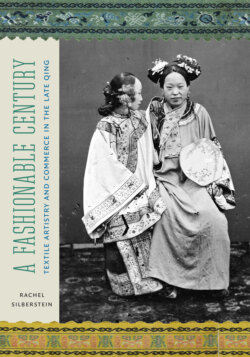A Fashionable Century

Реклама. ООО «ЛитРес», ИНН: 7719571260.
Оглавление
Rachel Silberstein. A Fashionable Century
CONTENTS
PREFACE
TERMS, ABBREVIATIONS, AND CHRONOLOGY
Introduction
FASHION AND CHINESE HISTORY
PART ONE
Creating Fashion. through the Dynasty
Visualizing Fashion
ETHNICITY, PLACE, AND TRANSMISSION
“Outlandish Costume. and Strange Hats”
MORAL DISCOURSES OF FASHION
Workshop, Boudoir, Village
PRODUCING EMBROIDERED DRESS
PART TWO
Plays and Poems
Performance, Print, and Pattern
POPULAR CULTURE IN FASHION
“The Luxury of Words”
FASHION AUTHORITIES AND ASPIRATIONS
Conclusion
ACKNOWLEDGMENTS
APPENDIX 1
APPENDIX 2
APPENDIX 3
APPENDIX 4
GLOSSARY
NOTES
PREFACE
INTRODUCTION
CHAPTER 1. VISUALIZING FASHION
CHAPTER 2. “OUTLANDISH COSTUME AND STRANGE HATS”
CHAPTER 3. WORKSHOP, BOUDOIR, VILLAGE
CHAPTER 4. PERFORMANCE, PRINT, AND PATTERN
CHAPTER 5. “THE LUXURY OF WORDS”
CONCLUSION
BIBLIOGRAPHY
ABBREVIATIONS
SOURCES
INDEX
Отрывок из книги
A FASHIONABLE CENTURY
IN THE LATE QING
.....
Decades of dragon robe–focused research created a model dominated by court taste or palace style (gong yang), in which styles originated in the capital’s courts and princely mansions and then circulated southward to more ordinary folk. In this model of fashion as conspicuous consumption, whereby imperial practice inspired domestic imitation, tastes ran from top to bottom: initiated by the upper classes, imitated by lower classes.53 This was how early Qing writer Ye Mengzhu understood fashion: “It likely begins in the gentry families, [then] their maids and concubines copy, and this gradually seeps through to their families and then catches on in the neighborhood.”54 And it was how many late Ming commentators interpreted fashion—it was something founded upon social mobility and competition.55 But though emulation is an undeniably powerful force in the social behavior governing fashion, the “trickle-down” processes that dominate classic sociological models of fashion like those of Thorstein Veblen or Georg Simmel have been discredited for overly simplistic mono-directional analysis, particularly for assuming that only elites can innovate, rather than multiway patterns of influence.56 Evidence from Chinese fashion counters such theories, showing instead the role of lower-class figures like courtesans and entertainers.
In the late Ming satirical novel The Plum in the Golden Vase, it is actually female entertainers rather than gentlewomen who exert the most influence: the protagonist Ximen Qing’s concubines anxiously assess the outfits of the sing-song girls who visit the house and with whom they compete for the favors of their master.57 Indeed, contrary to Ye Mengzhu’s account, most other commentators—from the late Ming through to the late Qing—singled out nonelite groups like courtesans and entertainers as integral to the Chinese fashion system: “In recent years, the clothing and adornment of men and women change roughly every few years. Men’s clothing and headwear styles follow the capital; all follow the trend of extravagance. [But] the women’s clothing and adornment all follow the courtesans’ styles, even women from good families follow this bad example, it is really very strange.”58 Their influence puzzled such commentators, but several factors explain why courtesans became tastemakers: their ties to entertainment and performance, their relative mobility and moral freedom, and their necessary expenditure on adornment and fashion.59 The relative freedom of entertainers, like servants, made them a point of contact, a mechanism by which new material culture could enter the homes of otherwise secluded women. But arguably their position as fashion arbiter was also a function of the gentlewomen’s absence, an absence created primarily by moral discourse.
.....